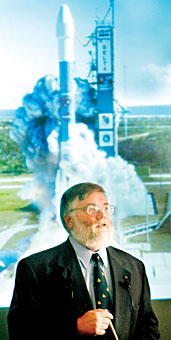 |
|
CLAIRE C. LAURENCE/Arizona Summer Wildcat
|
Regents professor H. Jay Melosh, a member of the Deep Impact science team, discusses some of his recent research involving the formation of craters at an open forum in the Kuiper Space Sciences building Saturday.
|
|
|
By Evan Pellegrino
Arizona Daily Wildcat
Wednesday, July 13, 2005
Print this
Scientists spoke on the success of the Deep Impact mission on July 3 and explained to a crowd Saturday about the effects and future research possibilities of the launch.
“We did it!” exclaimed UA regent professor H. Jay Melosh as a crowd of more than 350 Tucsonans erupted in applause in recognition of Melosh and the accomplishment of the Deep Impact Mission, which NASA is calling a smashing success.
Melosh, considered among scientists as one of the world’s foremost experts of impact craters, has played a pivotal role in the mission since its preliminary stages in 1995, when he helped make the first round of calculations.
The mission, to manually create a natural phenomenon in order to get humankind’s first look inside a comet, could help to unlock the mysteries orbiting the origin of the solar system.
The Lunar and Planetary Laboratory’s Public Outreach Program hosted the event Saturday evening in the Kuiper Science Building to provide the UA community with an opportunity to hear the initial results of this exciting exploration in space from Melosh, on his first day back to Tucson from mission control in Pasadena, CA.
The impact stage of the mission, which occurred on Independence Day for most of the nation, has already provided a wealth of images, data and insight about the geography, density, and composition of a comet. Its target, Tempel 1, is a potato-shaped, city-sized comet orbiting the sun 268 million miles from Earth.
The “fireworks” that resulted when the 820-pound impactor probe crashed into the comet at 6.4 miles per second immediately showed observers the initial success of the mission, Melosh said.
There was a “sufficient interaction,” a transfer of energy, explained Dante Lauretta, assistant professor of planetary sciences, who was on hand Saturday to answer questions.
The flyby spacecraft that housed the impactor for the 268-million-mile journey until 12 hours before impact, captured dazzling images of a flash of light and a plume of comet dust that slowly emerged from the impact site over the course of one-and-a-half hours after the collision.
Although the impactor’s journey was relatively short and the probe was destroyed in the process of creating the crater, its onboard camera collected spectacular images during its speedy 23,000 mph decent into the comet.
From these images, an incredibly defined landscape full of cliffs, mesas, both smooth and rough terrain, and circular features resembling craters can all be seen.
The process of how these geological distinctions formed will likely be debated by scientists for some time, but the images collected give a closer and clearer look than ever before.
According to Lauretta, images from this mission will be used in textbooks for years to come.
Many who attended the event hoped to be among the first to learn the dimensions of the crater produced by the probe.
Melosh said he did not feel comfortable speculating at this time but he did tell the audience to “think big.”
“The comet is unimaginably weak,” Melosh said. The surface is “weaker than the finest powder snow you can imagine.”
Melosh said the crater may be larger than initially predicted and he compared the plume of dust to a large cloud of talcum powder thrown into the air. While staying relatively suspended, it is hard to see through.
Melosh explained that the dust remains hanging above the crater due to the enormously low gravity Tempel 1 creates, which is 1/10,000 of the gravity we experience on Earth.
Although the unanticipated amount of dust ejected during the impact is blocking visibility, preventing scientists from giving definitive results to the size of the crater, the nature of the dust is providing valuable information on the composition of the “fluffy” comet.
Within the dust, vaporized water and carbon dioxide molecules have been detected by the flyby probe’s spectrometer. Scientists and computers will continue to analyze data for years to come, revealing the implications of the molecules’ presence.
Liquid water is not possible due to the pressure of the environment, but Melosh said there might be data in the future revealing the presence of ice or dry ice.
Melosh explained that it is uncertain if all comets are the same. In other
words, it is unclear if every comet can be generalized based on the exploration of Tempel 1.
As questions are answered, more questions will develop. Thousands of researchers and instruments all over the world and in outer space, including the flyby spacecraft still orbiting the comet, will continue to probe Tempel 1 for more information.
Melosh said the mission is in its very early stages in terms of data collection and processing and he expects the discoveries of this mission to possibly rewrite current models of comets.
In addition to Melosh’s lecture, Saturday’s program also included children’s activities and a Deep Impact DVD viewing.
